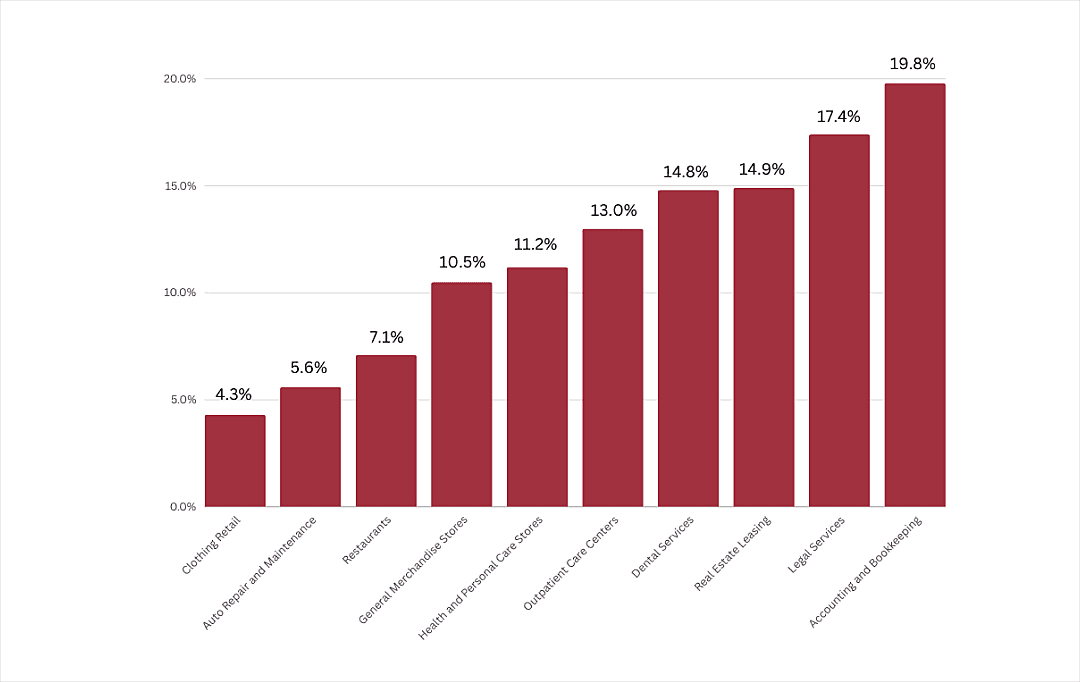
- Understanding What is a Profit Margin
- Types of Profit Margins
- Small Business Profit Margin by Industry
- What is a Good Profit Margin for a Small Business?
- Differences Between Gross and Net Profit Margins
- Factors Affecting a Good Profit Margin
- Strategies to Improve Profit Margins
- Practical Tips for Small Business Owners
- Key Takeaways

Profit margin signifies that portion of sales above the cost of production. It is such an important yardstick in the company’s financial status since it helps determine how effective a company is in terms of controlling costs relative to what they make. The Profit margin goes beyond mere awareness of your numbers. It is an understanding of your price mechanism, cost management, and general productivity. Startups are vastly dependent on having a healthy margin of profit for sustainability and growth. This is especially crucial when considering the stages of a startup, where profitability can make or break the business.
This comprehensive guide will walk you through the maze of good profit margins. It will help you with effective methods and tactics to improve your business's financial health and sustainability in the long run by sharing how much profit margin is good.
Understanding What is a Profit Margin
Profit margin is a measure in monetary terms, indicating how much of revenue in percentage comes in over and above the costs of production. It can be obtained through the division of net income by revenue, then by multiplication by 100. Therefore, if a company had a net income amounting to $10,000 while at the same time it realized a revenue of $100,000, then the profit margin would be 10%.
Profitability is a key metric of the health of the business. High margins mean the business is handling its costs effectively with respect to revenues, which is vital for long-term growth. This helps the startups evaluate their pricing strategies and cost control measures, ensuring they are still competitive and profitable in the market. When starting an online business one needs to understand what profit margins are.
Types of Profit Margins
Understanding them in three types will give you full insight into the margin: gross profit margin, operating profit margin, and net profit margin.
1. Gross Profit Margin
The gross profit margin is what you have left after you sell products. Typically, a good gross profit margin indicates that the company produces efficiently.
2. Net Profit Margin
The net profit margin denotes the income left after all subtractions have been done such as taxes, costs, and miscellaneous spending hence revealing the overall company’s performance in terms of profit-making. When a company has a high net profit margin it indicates good health as far as financial operational capabilities are concerned.
3. Operating Margin
Operating profit margin helps in understanding the company’s health more specifically using the COGS, operating expenses, and remaining revenue.
Small Business Profit Margin by Industry
There are significant disparities in profit margins in industries which are due to different cost structures among industries, their competitive behaviors, and the prevailing market conditions. Having such insights is imperative for small-scale entrepreneurs who need to measure and establish genuine economic objectives. For instance, manufacturing or retailing has lower margins as opposed to service-oriented firms like consultants or software developers, still they also widely differ under each category.
Industry data indicates that the average profit margin in the software industry is typically 20-25%, compared to 2-5% for the retail industry. Here are some examples of average profit margins in different industries:

What is a Good Profit Margin for a Small Business?
In industry-specific small business earnings, it is customary to use a broad concept. A healthy profit margin is crucial in managing a small business if we want the firm to grow and survive. On a net profit margin basis, 10% is average, 20% high (good) and 5% low.
A good profit margin for a product is one that manages the cost of operation and revenue in a well-balanced approach, while a high margin indicates sound financial health and good operating efficiency. For example, a consulting firm would aspire to high margins because overhead investments are low. However, a retail business would work on low margins, with higher investments in inventory and operational expenses.
Areas such as technology, pharmaceuticals, and financial services are ranked highly in the business world because they have innovative products that firms are attracted to as they can help in making savings on their investment while getting good returns. They are usually many in number because producing capital is expensive and variable costs are low hence firms looking for where to maximize their profits while at the same time ensuring their long-run financial stability usually go there.
Differences Between Gross and Net Profit Margins
It is important to appreciate the difference between gross and net profit margins so that a comprehensive financial analysis is undertaken. These metrics offer insights into different aspects of the financial health and efficiency of a business.
Good Gross Margin
A good gross margin shows the efficiency of processes in production. It shows the percentage that revenues exceed COGS. To get a good gross margin, you need to focus on the immediate costs related to the direct costs of making the goods or services comprising raw materials and labor. It is important to consider this metric when evaluating the efficiency of cost control in an organization.
Calculation
Gross Profit Margin = [(Total Revenue - COGS) / Total Revenue] x 100
Example
If total revenue were $200,000 with a COGS of $120,000, the margin would then come out at 40% which is considered a good gross margin.
Net Profit Margin
Net profit margin provides an illustration of a company’s general ability to remain profitable after all its expenses, taxes and costs have been deducted. It includes both direct and indirect costs such as interest, operating expenditures and taxes leading to a broader perspective concerning the firm’s financial wellbeing. The companies which are more financially stable and successful possess higher net profit margins
Calculation
Net Profit Margin = (Net Profit / Total Revenue) x 100
Example
For example, if a company generates a net profit of $30,000 off total revenues of $200,000: it would have a 15% net profit margin.
Factors Affecting a Good Profit Margin
Factors influencing the ideal profit margin for small businesses will include, among others understanding the elements that will enable companies to put in place strategies that improve their financial health for the sake of long-term sustainability.
1. Pricing Strategies
The pricing for the products or services is important. Competitive pricing might bring in more customers but could decrease margins. Alternatively, a thoughtful implementation of premium pricing might bring in more margins but result in a limited customer base. This is how to keep the margins decent. Effective marketing for small businesses can help in finding the right balance. Additionally, partnering with the best startup accelerators can provide valuable resources and mentorship to refine pricing strategies.
2. Cost of Goods Sold (COGS)
The cost of production or service delivery eventually affects the profit margin. The business should, therefore, try to negotiate better deals with suppliers, improving efficiency in production and reducing wastage, thereby ensuring that the cost of goods sold is kept at bay. Keeping the COGS low without compromising quality helps attain an ideal profit margin for small businesses.
3. Market Competition
The intensity of competition in the market determines pricing power and, thus, profit margins. Firms in very competitive markets may need to cut prices to maintain the competitive lead, squeezing their margins. Knowing the market dynamics and differentiating products or services help in sustaining higher margins. Consulting with the best startup consulting firms can provide insights on how to navigate competitive markets.
4. Economic Conditions
Economic factors, including inflation, interest rates, and economic growth, can influence consumer buying power and business costs, respectively, in turn bringing a good profit margin. This requires adjustment to ever-changing economic conditions to sustain profitability.
5. Labor Costs
The profitability of a business can easily be affected by employment costs like wages, benefits, and taxes. The profit margins are improved by effective human resource management and utilization of automated systems.
6. Technology and Automation
Technological investments and automation of activities can lower costs for businesses and make them more effective, thus improving margins. Such technological applications as AI, machine learning, and RPA can assist in fast-tracking operations and reducing the costs of manual labor.
7. Good Operating Margin
Good operating margins are the result of operational efficiency. That means lower costs and higher productivity mean a good profit margin. Some of these strategies to increase operational efficiency include the improvement of the supply chain, reduction of waste, and enhanced productivity of labor.
Such focus areas shall help companies enhance their profitability and create long-term growth. Implementing marketing strategies for startups can also enhance operational efficiency by targeting the right audience effectively.
Strategies to Improve Profit Margins
Small businesses need to increase their earnings if they want to stay afloat and flourish. A couple of strategies to help improve your profit margins include:
1. Profit Margin Calculation and Analysis
When tasked with finding how much profit margin is good, you should use tools and software for tracking financial metrics to ensure correct and uniform calculations. Usually, a good profit margin is anything above 10% in major industries. Utilizing PPC for startups can also aid in analyzing the effectiveness of marketing campaigns in improving profit margins.
2. Cost Reduction Strategies
To enhance profit margins, it is extremely important not to reduce quality at the expense of cost-cutting. Through the application of lean manufacturing practices, however, enterprises can cut on waste and inefficiencies. Thereby, leading to considerable reductions in their costs.
Cutting unnecessary costs that are not adding value to the quality of the product or service can help organizations reduce their operational expenses. Hence improving their bottom line.
3. Revenue Enhancement
Boosting typical profit margins significantly is possible. Upselling at the point of sale and convincing current clients to purchase related products positively affects the amount of money realized from sales, thereby growing one's income revenues. Brainstorming service business ideas can open new revenue streams.
When a company explores fresh markets or customer sectors, it stands a chance of earning other sales. A firm must continually come up with new ideas and spread out what it is offering so that it remains in the race with others and fulfills ever-changing client requirements.
4. Improving Operational Efficiency
Improving operational efficiency is synonymous with increasing your profit margins. To achieve this goal it is important to streamline what already exists, Thereby, helping you produce more while spending less on production. The effectiveness of running logistics, bringing down costs, and shortening customer’s waiting time depends on satisfactory supply chain management.
Identifying and eliminating production or service delivery bottlenecks can increase efficiency. Regularly evaluating and refining operational processes can help businesses maintain high efficiency and profitability.
5. Technology and Automation
If you invest in technology and automation, you can decrease labor costs significantly and enhance productivity. Automatic systems are capable of performing repetitive work as well as enhancing the quality of products. Thus, enabling employees to concentrate on more important activities.
The introduction of AI, ML, and RPA for instance really supports the productivity of operations by providing an edge through profitability increase while focusing on what the worker can do better than others.
6. Customer Relationship Management (CRM)
The introduction of CRM systems may improve client maintenance and retention levels, which in turn leads to increased profitability and improved profit margins. Effective CRM strategies mean that the firms better understand the requirements of their clientele by personalizing the interactions and establishing long term connections.
Additionally, CRM systems enable companies to effectively match their sales and marketing strategies with customers’ behaviours solved below was well.
7. Optimize Checkout Process
Reducing cart abandon cases can be achieved by streamlining the checkout system. The essential factors in this case are to make the e-commerce site customer-friendly, secure, and aligned with client expectations. One way of realizing this goal is through platforms that create functional and trusted payment systems. Ensuring a smooth checkout process can significantly enhance customer satisfaction and conversion rates.
When companies press for higher sales through increased customer attraction and trust, they must streamline the shopping process. They must also display security badges, which would increase confidence in the completion of orders by enabling various payment channels.
Practical Tips for Small Business Owners
There are some specific tips that individuals who run small businesses can use to find out what profits they make and try to increase the same profits.
- Regularly Review Financial Statements: Review financial statements like income statements, balance sheets, and cash flow to evaluate the firm’s growth. The activity allows for well-grounded decision-making, based on facts.
- Focus on Customer Satisfaction: Happier clients are likelier to come back and make referrals to others about your business, therefore raising the sales, which consequently raises the profit margins you make from the sales process.
Making sure your clients are satisfied involves giving them a great customer service experience, seeking feedback from them, and solving any problem they may report promptly. An example is when you send a feedback email to your customer appreciating them for making a purchase.
- Innovate and Cut Costs: In order to remain competitive and boost their profit margins, companies must constantly develop their goods and services, cutting their expenses effectively. Identify ways to reduce costs but still maintain good quality. The latter can be attained through embracing the latest technology, optimizing logistics chains, or simplifying procedures.
For instance, by using automation in manufacturing we can obtain a cost-effective workforce and better productivity. To keep production costs as low as possible, you have to eliminate all those things that are not necessary and then get back on them once you’ve done what is needed.
- Leverage Technology: Maximizing technology and automation are crucial drivers for efficiencies, reduction in labor costs, and productivity growth. Tools like CRM systems, project management software, and automated marketing solutions simplify operations and therefore improve profitability.
For example, the use of a CRM tool may simplify how you handle relationships with your customers. This will help you keep them and promote more purchases while at the same time increasing their numbers.
- Improve Operational Efficiency: To attain a good typical profit margin it is essential to enhance operational efficiency. This can be met by optimizing your supply chains. Hence, leading to reduced expenses and better lead times. You can start minimizing waste via a lean manufacturing approach and increasing labor productivity through staff training and technology use.
-
Enhance Marketing Strategies: Sales may increase only if you use effective marketing strategies. To optimize your campaigns, engage in targeted efforts to reach your target client base with data-driven methods. If you want to continue expanding your reach as well as retain more customers, start using social media for instance email marketing alongside search engine optimization (SEO). Leveraging startup branding can also enhance your visibility and appeal.
- Monitor and Adjust Pricing Strategies: Ensure reviewing and adjusting of price strategies that are in alignment with recent market situations and the objectives of the company. For you to set the prices, consider what market competition looks like and listen to clients’ opinions. By changing prices strategically, you can increase sales while raising profit margins.
If for example, a rival decreases her charges, adjusting your payment scheme or enhancing the quality of services will safeguard your market share; alternatively should there be an outburst in demand for goods then raising of prices remains viable without losing clients’ interest.
Key Takeaways
Small business sustainability and growth crucially depend on the comprehension and regulation of a good net profit margin ratio. One can learn a lot about financial health through regular analysis of gross, net, and operating profit margins. Again, having the best startup ideas and comparing oneself with industry standards offer a way of setting attainable targets and figuring out the areas that require improvement.
It is important to focus on using technology effectively to better manage costs and increase income. This can be done while ensuring customer satisfaction and regularly evaluating financial strategies to guarantee success for many years. To remain both in competition and economically stable, a business must keep costs under control and add value; in other words, maintain a healthy profit margin.


















